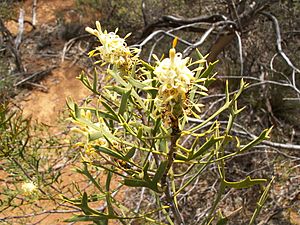Petrophile shuttleworthiana facts for kids
Quick facts for kids Petrophile shuttleworthiana |
|
|---|---|
 |
|
| In the Wongan Hills district of Western Australia. | |
| Scientific classification | |
| Genus: |
Petrophile
|
| Species: |
shuttleworthiana
|
| Synonyms | |
|
Petrophila shuttleworthiana Meisn. orth. var. |
|
The Petrophile shuttleworthiana is a special flowering plant that grows only in the south-west part of Western Australia. It belongs to the Proteaceae plant family. This plant is a bit prickly and looks like a shrub. It has pretty creamy-white flowers. You can find it growing within about 400 kilometers (250 miles) of Perth.
Contents
What Does the Petrophile Look Like?
The Petrophile shuttleworthiana is an upright shrub that can grow up to about 2 meters (6.6 feet) tall. Its branches and leaves are smooth, meaning they don't have hairs. The leaves are quite small, about 3.5 to 7 millimeters (0.14 to 0.28 inches) long. They are deeply divided into 3 to 7 stiff, pointed sections.
The flowers are about 11 millimeters (0.43 inches) long. They are usually cream, creamy white, or yellow and also feel smooth. These flowers grow at the very end of the stems. You can usually see them blooming in the spring.
How the Petrophile Got Its Name
A Swiss scientist named Carl Meissner first officially described this plant in 1856. He studied a plant sample collected in 1844 near the Swan River. The sample was found by another botanist, James Drummond.
The second part of the plant's scientific name, shuttleworthiana, honors an English collector and botanist named Robert J. Shuttleworth. He was also interested in snails. The closest plant relative to Petrophile shuttleworthiana is another plant called Petrophile macrostachya.
Where Does the Petrophile Live?
The Petrophile shuttleworthiana grows in several different areas of Western Australia. These include the Avon Wheatbelt, Geraldton Sandplains, and Swan Coastal Plain. You can find it from the Moore River in the south all the way north to Kalbarri.
This plant likes to grow in areas with low, dense plants called heath. It also lives in shrubland or mallee areas. It prefers to grow in grey-yellow sand. Sometimes, this sand might have gravel or a type of hard soil called laterite.
Images for kids
-
A close-up of Petrophile shuttleworthiana in the Wongan Hills district.


